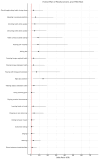The Impact of Parafunctional Habits on Temporomandibular Disorders in Medical Students
- PMID: 40806923
- PMCID: PMC12346914
- DOI: 10.3390/jcm14155301
The Impact of Parafunctional Habits on Temporomandibular Disorders in Medical Students
Abstract
Background: Temporomandibular disorders (TMD) are common musculoskeletal conditions affecting the temporomandibular joints, masticatory muscles, and associated structures. Their etiology is complex and multifactorial, involving anatomical, behavioral, and psychosocial contributors. Parafunctional habits such as clenching, grinding, and abnormal jaw positioning have been proposed as contributing factors, yet their individual and cumulative contributions remain unclear. This exploratory cross-sectional study aimed to evaluate the prevalence and severity of parafunctional habits and their association with TMD in medical students-a group exposed to elevated stress levels. Subjects were examined in Krakow, Poland, using the Diagnostic Criteria for Temporomandibular Disorders (DC/TMD) protocol. Methods: Participants completed a 21-item Oral Behavior Checklist (OBC) assessing the frequency of oral behaviors on a 0-4 scale. A self-reported total parafunction load was calculated by summing individual item scores (range: 0-84). Logistic regression was used to evaluate associations between individual and total parafunction severity scores and TMD presence. Results: The study included 66 individuals aged 19-30. TMD was diagnosed in 55 participants (83.3%). The most commonly reported habits were resting the chin on the hand (90.9%) and sleeping in a jaw-compressing position (86.4%). Notably, jaw tension (OR = 14.5; p = 0.002) and daytime clenching (OR = 4.7; p = 0.027) showed significant associations with TMD in the tested population. Each additional point in the total parafunction score increased TMD odds by 13.6% (p = 0.004). Conclusions: These findings suggest that parafunctional behaviors-especially those involving chronic muscle tension or abnormal mandibular positioning-may meaningfully contribute to the risk of TMD in high-stress student populations. Moreover, the cumulative burden of multiple low-intensity habits was also significantly associated with increased TMD risk. Early screening for these behaviors may support prevention strategies, particularly among young adults exposed to elevated levels of stress.
Keywords: DC/TMD; bruxism; jaw muscle tension; medical students; oral behaviors; parafunctional habits; stress; temporomandibular disorders; temporomandibular joint; young adults.
Conflict of interest statement
The authors declare no conflicts of interest.
Figures
Similar articles
-
Prevalence of Temporomandibular Disorder Symptoms Among Dental Students at the Faculty of Dental Medicine in Iași: A Self-Reported Study Based on DC/TMD Criteria.Diagnostics (Basel). 2025 Jul 30;15(15):1908. doi: 10.3390/diagnostics15151908. Diagnostics (Basel). 2025. PMID: 40804872 Free PMC article.
-
Prescription of Controlled Substances: Benefits and Risks.2025 Jul 6. In: StatPearls [Internet]. Treasure Island (FL): StatPearls Publishing; 2025 Jan–. 2025 Jul 6. In: StatPearls [Internet]. Treasure Island (FL): StatPearls Publishing; 2025 Jan–. PMID: 30726003 Free Books & Documents.
-
Association Between Gum Chewing and Temporomandibular Disorders.J Clin Med. 2025 Jul 24;14(15):5253. doi: 10.3390/jcm14155253. J Clin Med. 2025. PMID: 40806875 Free PMC article.
-
Occlusal interventions for managing temporomandibular disorders.Cochrane Database Syst Rev. 2024 Sep 16;9(9):CD012850. doi: 10.1002/14651858.CD012850.pub2. Cochrane Database Syst Rev. 2024. PMID: 39282765
-
Psychological therapies for temporomandibular disorders (TMDs).Cochrane Database Syst Rev. 2022 Aug 11;8(8):CD013515. doi: 10.1002/14651858.CD013515.pub2. Cochrane Database Syst Rev. 2022. PMID: 35951347 Free PMC article.
References
-
- Progiante P., Pattussi M., Lawrence H., Goya S., Grossi P., Grossi M. Prevalence of Temporomandibular Disorders in an Adult Brazilian Community Population Using the Research Diagnostic Criteria (Axes I and II) for Temporomandibular Disorders (The Maringá Study) Int. J. Prosthodont. 2015;28:600–609. doi: 10.11607/ijp.4026. - DOI - PubMed
-
- Paulino M.R., Moreira V.G., Lemos G.A., da Silva P.L.P., Bonan P.R.F., Batista A.U.D. Prevalence of signs and symptoms of temporomandibular disorders in college preparatory students: Associations with emotional factors, parafunctional habits, and impact on quality of life. Prevalência de sinais e sintomas de disfunção temporomandibular em estudantes pré-vestibulandos: Associação de fatores emocionais, hábitos parafuncionais e impacto na qualidade de vida. Cienc. Saude Coletiva. 2018;23:173–186. doi: 10.1590/1413-81232018231.18952015. - DOI - PubMed
LinkOut - more resources
Full Text Sources


